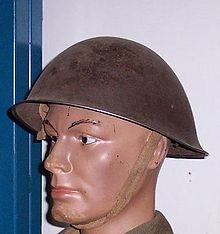Mk III helmet


The Type Mk III Helmet was a steel military helmet developed for the British Army in 1944. First worn in combat by British and Canadian troops on D-Day, the Mk III was used alongside the Brodie helmet for the remainder of the Second World War. It is sometimes referred to as the "turtle" helmet by collectors, because of its vague resemblance to a turtle shell.
The Mark III helmet was designed to provide better protection for the side of the head than its predecessor. It was a deeper helmet with a smaller brim and provided 38% more protection than the Mark II, particularly at the sides. The Mark III helmet was issued primarily to assault troops for the Normandy invasion in June 1944, and a large number of helmets from British stocks were issued to the 3rd Canadian Infantry Division in addition to British units. Small numbers also went to the 2nd and 4th Canadian Divisions. All Mark III helmets in Canadian stores were returned to the British shortly after the end of the Second World War.
The Mk III gradually replaced the Brodie helmet from 1944 onwards. The Mk III was itself replaced after the war by the Mark IV helmet, which it closely resembled. The main differences were that the rivets attaching the chinstrap to the helmet were placed much higher up on the shell. There were additional differences with regard to the helmet liner. The Mk IV helmet was used until the 1980s at which point the British replaced all steel helmets with ones made from kevlar.

